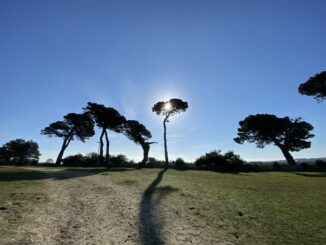
So where’s Vince now? After a second day in Honfleur we now find ourselves in Arromanches-les-Bains on the coast as we make our way west to Brittany. It was a lazy second day as we only managed to walk into town to visit the Maritime Museum and wander the pretty little back streets which seem to have been painted by practically every famous French artist.
An early night and an early start saw us taking the country lanes along the coast. It might not have been the smartest decision to take the scenic route – Vince could barely fit down some of the lanes Mr Garmin recommended but we arrived safe and sound in the end. Today we are parked up in a free aire right in the centre of Arromanches. There are only ten spaces so demand is high. We nicked the last space and all afternoon motorhomes have been turning up then driving away disappointed, it’s clearly a popular destination. They don’t have to go far as the municipal campsite backs on to the aire. There’s a little gate behind us which connects to the campsite – an unscrupulous motorhomer could even sneak through for a cheeky free shower, ahem…
Arromanches is world-famous for its role in the D-Day landings. It’s right beside Gold Beach, one of the five jumping off points for the Normandy landings on 6th June 1944.
“The allies had attempted, and failed, to capture a French port in 1942 with the disastrous commando raid against Dieppe. As a result of this they knew that to capture a port in the early days was impractical so another means had to be found.
The solution was the Mulberry harbours. Two temporary harbours, each the size of the port of Dover, were built of prefabricated sections in Britain then towed to Normandy in the wake of the invading armies. In a ferocious building program the pieces were put together on the beaches of Normandy, creating two operational harbours within two weeks. Mulberry A, located off St. Laurent on Omaha beach was allocated to support the American forces. Mulberry B was located at Arromanches les Bains, adjacent to Gold beach, and intended to support the British and Canadian forces. Mulberry A was all but destroyed by a massive storm that hit the Normandy area between 19 and 21 June. However, Mulberry B, although badly damaged by the storm, was repaired and continued in operation until late November greatly exceeding the original 90 day design period.” (Credit)
The D-Day Museum is well worth a visit as it explains the construction of the Mulberry harbours and how they were shipped across the Channel.
Even after 72 years there are remains of the harbour visible all over the beach and out to sea as some of our pics show below. Tomorrow we plan to visit the 360 degree cinema for more information about the D-Day landings then we’ll head off at lunchtime. No idea where yet! Last minute planning is all part of the fun…








It’s like a holiday journal and history lesson all rolled into one….keep ’em coming!
Was there many many years ago with the girls , a moving experience.
I believe seeing pictures that the giant pontoons were made in Cairnryan on the west coast of Scotland. That means they had to be towed a heck of a distance to the Normandy shores. A superb piece of engineering when Britain was actually able to “make” things.